Custom Weld
Metal for Arctic Pipeline
by Richard A Harris,
Associate Editor for Welding Design & Fabrication
Laying a pipeline under Alaska's Beaufort Sea reminds Will Bellis of laying pipe across a river, except the crew works on an 8 foot thick platform of ice floating in the Arctic Ocean, temperatures drop to 70 below zero, and polar bears may come for lunch.
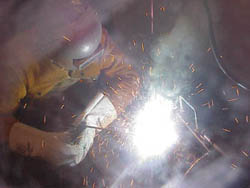
|
Houston Contracting welders on the BP Northstar Project use
Lincoln Electric Shield Arc 80 electrodes (AWS E8010-G) -- an
80,000 psi tensile strength to join 10-inch diameter, 0.594-inch
wall thickness API 5L Grade X65 pipe onshore and X52 offshore.
The electrodes were made with single heat and batch control for
the marine portion of the pipeline.
|
|
Bellis is the Houston Contracting Company project manager for the BP Amoco Northstar Project. It's the first sub-sea pipeline project connecting an offshore drilling island to shore. Two 10-inch diameter pipes, one for gas, one for oil, run 12 miles under the ocean and 21 miles on shore to Pump Station One of the TransAlaska Pipeline at Prudhoe Bay. Plans call for completion in May.
The sweet oil is sweet, with low hydrogen sulfide and carbon dioxide. It had little effect on the pipeline design. The major design criteria is strain due to ice gouging and thaw settlement.
Houston Contracting Company (HCC) is one of the oldest union pipeline construction firms in the United States. Working with such clients as ARCO and Alyeska Pipeline Service Company, Houston has built pipelines and oil and gas gathering facilities throughout Alaska's North Slope. BP Exploration, a division of BP Amoco, selected HCC to build the first sub-sea pipeline in arctic Alaska. "I know this pipeline will be the best one built in Alaska," says Bellis, "because it's the first offshore pipeline in the Arctic ocean, many people are looking at it with magnifying glasses." He earned a Welding Engineering Technology from California Polytechnic College. Then he worked for 15 years as a welding engineer and project engineer in the Gulf, Texas, and California fabricating storage tanks and truck trailers before joining Houston Contractors on recommendation of friends from school.
"Houston Contracting has built more pipelines than any other company on the North Slope," states Bellis, "but the Northstar pipeline stands alone as a spectacular accomplishment."
Million Dollars to Qualify Weld Metal
"The electrode we're using is the standard E8010-G (AWS A5.5-95) electrode to weld the onshore and offshore sections," says Bellis. "But it has gone through a million dollars of testing to qualify for this project.
"We intentionally implanted the maximum flaws in tension zones during procedure testing. Labs did full-scale bend tests where the pipe was taken below the minimum design temperature. It was pressurized and taken beyond three times the maximum estimated strain based on the engineering criteria. They then bent the pipe to the failure point and tested for leaks. We needed to prove that the welding procedure supported the strain-based limit state design," states Bellis.
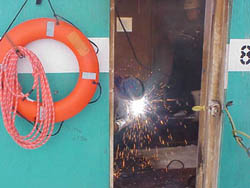
|
Houston Contracting welding crews work in heated portable
buildings with handy safety equipment. On-site safety
equipment includes throw rings, hooks, and hypothermia
equipment, such as a Res-Q-Air inhalant warm air delivery
system and special sleeping bags. An emergency medical
crew is on site with an ambulance
|
|
"In addition, we had to provide answers to questions on low temperature toughness. The CTOD (ASTM E1290-99 Standard Test Method for Crack-Tip Opening Displacement Fracture Toughness Measurement) testing was done with engineering criteria analysis to developed flaw criteria and maximum allowable flaw size."
One Heat, One Batch of Electrodes
"We required special controls for the electrodes, as is required in the most stringent standards," explains Bellis. "We asked Lincoln Electric to make E8010-G electrodes with heat and batch control, which was not standard, for the marine portion of the pipeline."
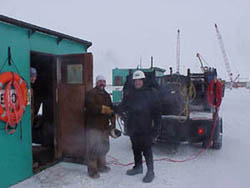
|
Welding crews work draw power from truck mounted Lincoln
Electric SA 250 power sources. These provided DC positive
for the stringer passes and DC positive for the hot and filler
passes. Will Bellis, Houston Contracting project manager (right)
congratulates Shane Bowen, welder, and Mark Mitchell, helper,
for their good work.
|
|
Lincoln Electric teamed with distributor Airgas in Alaska to manufacture a special run of Shield Arc 80 electrodes -- an 80,000 psi tensile strength consumable designed for pipe welding. The firm assigned a team of engineers to the project. It manufactured each electrode diameter from one heat of steel and under controlled chemical composition, both of the steel core wire and the coating mixes. Before leaving the Lincoln facility, internal testing of weld metal mechanical properties and X-ray soundness determined that the electrodes fell within the acceptance range and that they were certified to American Welding Society (AWS) A5.01 and A5.5 specifications.
Lincoln supplied nearly 20,000 lb. of electrodes in three diameters (3.2 mm, 4 mm, and 5 mm) for this project.
The electrodes were air shipped in hermetically sealed cans and special packaging to Alaska for CTOD testing. This testing simulated the field welding conditions using liquid nitrogen to cool the pipe and then applying flex tests.
"Lincoln Electric went out of their way to manufacture the electrodes to BP Amoco's strict set of parameters," said Mark Bradley, area manager, Airgas Alaska. "I think this is a testament to the way the company is willing to work with customers to custom-tailor electrodes for their individual needs."
"During the weld procedure qualification we also tested the weld metal for diffusable hydrogen because it is subject to cold cracking and found a surprising low hydrogen content, less than 5 ml H2/100 grams, because of diffusion during multiple passes," states Bellis. "This is similar to the hydrogen content of a single bead of a basic low-hydrogen electrode."
Qualified NDE
Plus, Houston had the nondestructive examination (NDE) processes qualified.
As a blind sample, Houston sent five pipe coupons with implanted flaws in the welds to two labs. The labs had to map the flaws using automated ultrasonic testing (AUT). Then at a different lab the welds were analyzed to find the actual flaw size and location for comparison the UT test map.
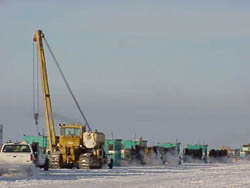
|
Operators use a boom mounted on Caterpillar 583 crawler
tractors to move a welding building along the pipeline.
|
|
Thus the UT contractors were rated on their technical capabilities. That was critical in the engineering design and development of flaw acceptance criteria. If the test labs under or overstated the size of the flaw it effected weld procedures on the job site. After testing, the UT contractors fine-tuned the equipment before arrival at the site.
On the Ice
More than 200 people work on the project during one shift, seven days a week. These include 21 certified welders from Pipeliner locals 375 and 798, and other locals.
Dial 911
Lead inspector Dwight Panter leads the training programs for special aspects of the welding procedure. Welders were qualified on a 6G test in Fairbanks prior to mobilizing to the North Slope. Crews also receive site orientation and safety training, including an 8-hour North Slope course on arctic safety and wildlife interaction. If you are planning a visit keep your lunch in zip-lock bags because polar bears have a keen nose for an easy meal.
Man-in-the-water drills, with a dummy, emphasize the serious conditions. Floating evacuation drills prepare the crews for storms. Workers stay 15 feet away from the trench, except during the pipe laying operation.
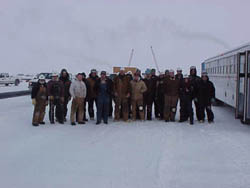
|
More than 200 people work on the project during one shift,
seven days a week. These include 21 certified welders from
Pipeliner locals 375 and 798, and other locals.
|
|
Safety equipment includes throw rings, hooks, and hypothermia equipment, such as a Res-Q-Air inhalant warm air delivery system and special sleeping bags. An emergency medical crew is on site with an ambulance. A medical clinic provides first aid.
Eight-Foot Thick Ice Pad
Houston Contractors selected the ice lay method, rather than a laybarge, because of shallow water, the first few miles are less than 10 feet deep, time limitations, and the threat of ice flows.
"By building up the ice," states Bellis, "we could treat the project exactly as on land with a river crossing. Our superintendents have vast experience in river crossings on the lower 48, and have worked up here for 8 to 10 years."
Sandwell Engineering designed the ice thickness to provide a platform to support people operating trenching, side booms, and other equipment, and welding equipment. The ice was built up to the required eight feet between December and February.
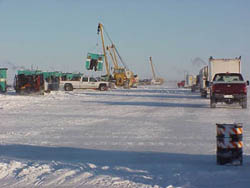
|
Welders on the BP Northstar Project use specially formulated
electrodes and special welding techniques to weld pipe sections
on the ice surface and lay the pipeline below Alaska's Beaufort Sea.
|
|
Operators first ran balloon-tired graders over the surface to smooth it. To build up the thickness, they used a truck with an auger to drill through the ice and a screw pump to bring sea water to coat the surface. It's a process similar to creating an ice rink. "We have to scarify the surface it to make it rough, so people don't slide around," says Bellis.
With the ice support built, a trencher carves a slot through the ice for the welded pipe and digs an 8 to ten foot deep ditch in the ocean floor. The ditch protects the pipe from ice burgs that can dig three feet with its keel. Dirt from the ditch is hauled to shore to minimize the weight on ice and stored. Then it is returned to back fill the pipe in the ditch.
Low Temperature Toughness
"We're using 10-inch diameter, 0.594-inch wall thickness API 5L Grade X65 pipe onshore and X52 offshore. The chemistry of the X52 provides higher low-temperature toughness.
The 40-foot length pipe came from Sumitomo Metal Industries and shipped to Seward AK by boat then via rail to Fairbanks. The Flowline Company coated the pipe with a fusion-bond epoxy (FBE) coating to provide durability. Trucks completed the delivery to the North slope.
Holding to the Standard
The pre-weld operations are standard for pipelines, a 30-degree bevel and preheat with propane torches to 175 degrees minimum. The welding crew uses CRC internal pipe clamps and positioners. The shielded metal arc welding schedules included tighter parameters to control heat input.
Welding crews work in heated shacks drawing power from truck mounted Lincoln Electric SA 250 power sources. These provided DC negative for the stringer passes and DC positive for the hot and filler passes.
A rock-wool blanket covering the weld controls the cooling rate as the weld cools to ambient temperature.
Welding inspectors thoroughly monitor power supplies settings. The six inspectors work with API 1104 and BP Exploration Alaska codes. "We use automated UT and X-ray by internal crawler and fine grain film to inspect the welds," states Bellis. "We use X-ray film for volumetric flaws and for sizing. The UT is used for planer flaws and to measure flaw height. We use X-ray and UT on each offshore weld and X-ray on the onshore welds."
After testing a worker coats each weld with the FBE coating. Crews bundle pipe into sections about two miles long with a leak detection system. Operators use lowering cradles mounted on Caterpillar 583 crawler tractors to place the line through the ice and into the trench. Operators clean the slot of major chunks just before laying pipe. The seawater stays unfrozen for about a half-hour. The crew surveys the top of pipe with an electric magnet to find the top of the pipe and confirm the depth.
Further information can be obtained from:
The Lincoln Electric Company
- Addr: 22801 St. Clair Ave. Cleveland, OH 44117 USA
- Tel: 216.481.8100
- Fax: 216.486.1751
- WWW: http://www.lincolnelectric.com/
- Email.
- Contact: Greg Coleman
|